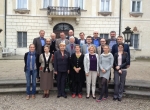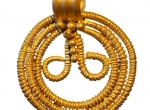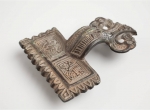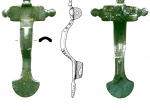The second meeting of the Project Team in Nieborów
2014.05.12 -
The second meeting of the Project Team took place at Nieborów, in Radziwiłł Palace, unit of the National Museum in Warsaw (photo 1) and was attended by the members of the Steering Committee and by Professor Wojciech Nowakowski, Director of the Institute of Archaeology University of Warsaw. The purpose of the meeting was reporting on the current outcomes of Project, planning and coordinating future work, hearing the views of Steering Committee members on progress made so far and their discussion.
Day One. Dr Marzena Przybyła (Jagiellonian University) reviewed the latest theoretical trends in migration studies and their applicability to the study of archaeological evidence. Professor Małgorzata Latałowa (University of Gdańsk) discussed the feasibility of making a chronological and spatial reconstruction of settlement processes in Pomerania, first millennium AD, with input from palynology analyses made so far and proposed some adjustments to further research to remedy the unimpressive results from last year’s fieldwork aimed on identifying viable palaeoecology sites in the region of Suchań and Kostkowice. Professor Aleksander Bursche (University of Warsaw) outlined the case of a Roman mint (Alexandria Troas) carried off by the Goths to investigate the mechanism of technological know-how transfer to barbarian communities which later would ease the processes of their adaptation within the Roman environment. Dr Marcin Wołoszyn (University of Rzeszów) analysed the reference in Procopius (→Procopius of Caesarea) to the migration AD 512 of the Heruli to the island of Thule noting that it the correct identification of the starting point of this migration is crucial for making a sound interpretation of this fragment of the written record.
The focus of the second part of the meeting were findings from the fieldwork made so far at Kroczyce – the Hanging Cave (mgr Marcin Rudnicki, University of Warsaw) - and the settlement site at Suchań (dr Bartłomiej Rogalski, National Museum in Szczecin). Dr hab. Anna Bitner-Wróblewska (State Archaeological Museum in Warsaw) and dr hab. Bartosz Kontny (University of Warsaw) presented the results of their study of the archives of Nils Åberg and Bernhard Salin relevant in studying the Migration Period archaeological record from Poland (→A research visit to Sweden). Drawing on archival records not made use of previously, Dr Anna Zapolska (University of Warsaw) discussed the founder’s hoard from Frombork (→Frombork ) and argued that culture attribution of this deposit is beside the point as, presumably, it was the property of an itinerant craftsman who was active on the Germanic and the Balt territory. Mgr Marcin Rudnicki reported on new and exciting findings datable to the mature Migration Period from the Kujawy region (photo 2), more notably, the settlement complex at Gąski-Wierzbiczany with a record on, e.g., the local production of brooches, 6th-7th cc. During the discussion they were interpreted as the first recorded confirmation of lingering Germanic tradition at the time of appearance of Slav settlement to the west of the Vistula River.
The proceedings on the first day closed with a discussion of technical matters related to the coordination and implementation of the Project. Emphasis was placed on the need to comply with new requirements of the National Science Centre, especially, the new guidelines on bibliography and publication format.
Day Two opened with a presentation by dr hab. Bartosz Kontny of a Merovingian brooch find from the Kujawy region (photo 3) which, given its unique character, should be interpreted as an import in the post-Przeworsk culture environment. Prof. Jan Schuster (University of Łódź), drawing on the results of analysis of two categories of brooches (photos 4 and 5), sought to demonstrate the long-distance nature of intercultural exchange connections with northern Poland observed at the onset of the Migration Period. The final presentation given by dr Ireneusz Jakubczyk (University of Łódź) addressed the feasibility of late dating of some tendril brooch variants recovered from cave sites in southern Poland.
The members of the Steering Committee emphasised the relevance of the research made within the Project for understanding the entirety of phenomena at work during the Migration Period in Barbaricum. They noted that in their future research the Project Team need to focus less on analysis of archaeological material and more on explication of processes unfolding between the Odra and the Vistula in the period 4th to 6th century. Next to evidence from palynology they are advised to make use of to a greater extent of other natural sciences and also to take into account the economic aspect of the observed changes. It was also suggested that the next annual meeting should be open to researchers and students Polandwide, and to representatives of mass media also. Most of the presented contributions should be published without delay. Everyone was agreed as to the momentous, breakthrough even, significance of the latest discoveries made in the Kujawy region, and the urgent need to carry out fieldwork on the site of the settlement complex at Gąski. The Project Leader explained that no provisions or funding were provided for in the MPOV grant application. In this situation the complex at Gąski cannot be studied within the present Project; nevertheless its archaeology definitely is reason enough for the research team working in the Kujawy region to make a new grant application.
The main guidelines and proposals of the Steering Committee shall be submitted to the National Science Centre and published on the Project web page.
-
 full resolution
full resolution
Photo 1. The Second Research Meeting at Nieborów – the participants.
-
 full resolution
full resolution
Photo. 2. A gold pendant from the Kujawy region (Photo by M. Rudnicki).
-
 full resolution
full resolution
Photo 3. The relief brooch from Radziejów (Photo B. Kontny).
-
 full resolution
full resolution
Photo 4. A brooch from Pamiątkowo, distr. Szamotuły (Photo J. Schuster).
-
 full resolution
full resolution
Photo 5. A brooch from Pyzdry, distr. Września (Photo J. Schuster).


